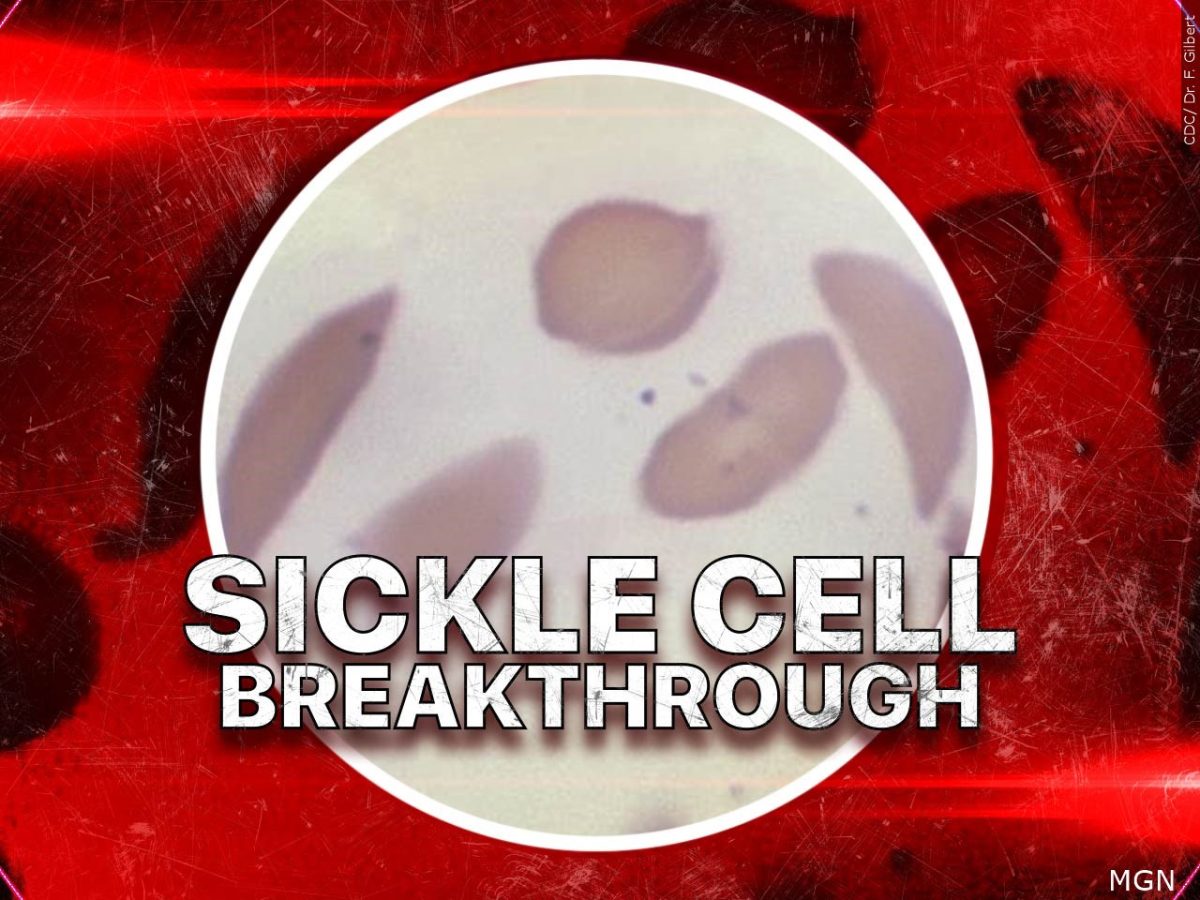Exa-cel, the new treatment for sickle cell anemia, is up for approval by the Food and Drug Administration, or FDA. The FDA has until Dec. 8 to approve exa-cel.
Sickle cell disease is an inherited red blood cell disease that causes the red blood cells to become hardened and shaped like a sickle. This causes people with sickle cell to have fewer red blood cells because the cells die early, and due to the abnormally shaped red blood cells that cause blockages in the blood vessels, certain parts of the body cannot get oxygen. These blockages can stop blood flow, leading to pain, stroke or infection.
This disease affects about 300,000 infants and is seen primarily in African Americans and frequently in Hispanic Americans and those in the Middle East.
There are multiple forms of sickle cell disease. Some of the most common are HbSS, HbSC and HbS beta-thalassemia. In children with sickle cell disease, each parent gives the child a gene that creates abnormal hemoglobin. If the parents are carriers for the sickle cell gene, their children can be born with it as well. It is often found during regular tests for newborns.
There are a few forms of treatment for sickle cell, one of which is called Hydroxyurea, which is used in patients two years old and older. Another treatment is L-glutamine, which is used in patients five years old and older. The other two treatments are called Voxelotor and Crizanlizumab.
However, only one treatment cleared by the FDA has been effective in treating sickle cell disease: a bone marrow transplant. This requires a close match to the person with sickle cell. In this procedure, the doctors remove bone marrow from the healthy person and put it into the person experiencing red blood cell issues.
This new treatment is a form of gene therapy that involves extracting cells from the person’s bone marrow and using a technology called clustered regularly interspaced short palindromic repeats, or CRISPR.
“Gene therapy is any way you can try to remedy a genetic disorder by providing the information to change the mutation in the sequence,” said Arnab Sengupta, a biology professor at GC. “We have talked about that as a case study for a very long time as well as the potential applications of CRISPR gene editing because sickle cell anemia arises from a point mutation in your DNA. So that is ultimately linked to the shape of the red blood cells. The goal here is, using CRISPR gene editing, can we go back and fix that mutation.”
After removing the stem cells, companies with the CRISPR editing technology will modify the genes to create the correct hemoglobin sequence and inject billions of copies of the edited gene back into the person’s body. This way, the body will copy the new gene, thus making healthy red blood cells.
“I know there is a debate about the ethics of gene therapy, and while I understand those concerns, as someone with an autoimmune disease, I am glad to see this technology on the horizon,” said Kaila Arnett, a senior sociology major. “It is really good to know that a lot of conditions that currently have little to no available treatment may someday be made manageable by gene editing.”
A committee of outside advisors spent their time assessing exa-cel and hearing from Vertex Pharmaceuticals, a biopharmaceutical company based in Boston, Massachusetts. Vertex is known for its drive to create innovative treatments for people with severe diseases.
On Oct. 31, Vertex partnered with CRISPR Therapeutics to create this new treatment for sickle cell. CRISPR Therapeutics is a Switzerland-based company that specializes in CRISPR technology, and they have dedicated years to understanding and advancing this technology.
“I think that extensive research will lead the FDA to approve this form of therapy, especially if it is extremely successful,” said Jayden Kypri, a freshman chemistry major.
The committee asked questions about the amount of research that went into the creation of exa-cel and if there had been any side effects from those who participated in the trials. This treatment is meant to be a one-time infusion, and Vertex has reported that in one of their studies, 39 of 40 patients did not report any blockages or pain. After hearing the participants’ testimonies and reading the numbers, the committee praised the treatment. This is usually the last step before the FDA approves or denies a new drug.
“The way drug approval processes work is several years in advance,” Sengupta said. “You have pilot experiments and studies, you have animal testing and then you have basically clinical trials, and that’s the phase where you slowly start to expand the number of volunteers you are testing. You are observing characteristics in those individuals, using some type of benchmarking to see if you are meeting the efficacy of the drug or not, meaning is it working in the way we were expecting it to work?”
If the FDA approves exa-cel, it will be the first treatment for any disease that uses gene editing technology.
“I have a lot of thoughts on the FDA, but I will say this: They have approved less substantiated methods before,” Arnett said. “I am also unaware of where scientists are in the process of beginning gene therapy, as I know it is still a very new technology, but I have faith that they will do their due diligence in testing, especially considering that there is not much more that could be at stake when you are editing the human genome.”
If approved, it could cost each patient up to $2 million dollars and require eight weeks of blood transfusions, and then they have the treatment done that releases the bone marrow stem cells into the bloodstream. Then, the stem cells will be removed and sent to be treated, and the patient will have to undergo chemotherapy to clear their marrow. Then, the treated cells are injected into the patient, and they need to stay in the hospital for at least a month while the new cells grow.
The cost may make it harder for everyone to get this treatment, especially in less well-off countries. Even Americans with low income may not be able to afford this treatment.
“I personally have no faith in the American healthcare system and know that while this technology will be able to help a lot of people, it will probably mostly be the people who can afford it because that is the system we live in,” Arnett said. “Unless there is some successful humane legislation regarding the technology, it is going to be stratified along class lines, just the same as the rest of healthcare in America; the cost of insulin upsets me every day. It is the unfortunate consequence of living under barely restrained capitalism.”
Vertex is trying to get Medicaid and other insurance companies to find the best way to make it more affordable. There are also concerns about how other countries where it is most prevalent can administer the therapy if they do not have the best equipment.
“If it is successful in the long run, capitalist hospitals will do anything to milk as much money out of it as they can,” Kypri said. “It is disgusting.”
If approved, it could be used for other severe diseases as well.
“CRISPR can be used for almost quite literally any type of disease, from diabetes to cancer,” Kypri said. “There is an insane amount of research that still needs to be done to further this claim. However, I do believe that it is possible!”


